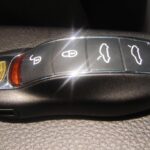Lost your Mitsubishi 380 car key or facing issues with your transponder? While “programming” a new key typically requires specialized equipment, there’s a temporary workaround designed to get you back on the road in a pinch. This guide will walk you through the immobilizer override procedure for your Mitsubishi 380, allowing you to start your car a couple of times without a properly programmed transponder key. This method is intended as a temporary measure to get you to a dealership or locksmith for a permanent solution.
Understanding the Immobilizer Override
Modern vehicles like the Mitsubishi 380 are equipped with an immobilizer system, a security feature that prevents theft by disabling the engine if the correct transponder chip isn’t detected in the key. This system usually requires a programmed key to communicate with the car’s computer and allow ignition. However, Mitsubishi has included an emergency override feature that can be activated using a specific brake code. This is not a substitute for proper key programming but can be invaluable in situations where you need to move your vehicle temporarily.
Gathering the Necessary Information
Before you begin, you’ll need to obtain your vehicle’s unique 4-digit Brake Override Code. This code is linked to your car’s Immobilizer-ECU (Engine Control Unit) and can be retrieved in one of two ways:
-
From Your Mitsubishi Dealer: The most reliable way to get the Brake Override Code is from your Mitsubishi dealership. They can access this information using your vehicle’s Immobilizer-ECU 8-digit serial number. To locate this serial number:
- Eclipse & Galant: Check the serial number tag located inside the glove box.
- Diamante: Look for the tag on the driver’s side trunk lid hinge bar.
- Montero Sport: The serial number tag is on the front of the driver’s side “B” pillar.
Once you provide the 8-digit Immobilizer-ECU serial number, the dealer can retrieve the 4-digit Brake Override Code from the Mitsubishi system (often found in their IMS Warrant Screen – Immobilizer Password Request screen).
-
From Previous Vehicle Documentation: In some cases, the Brake Override Code might have been provided with your vehicle documentation when you purchased the car. Check your owner’s manual or any security-related paperwork you received.
Important Note: The Immobilizer Override feature may not be available on all Mitsubishi 380 models, especially base models without factory-installed keyless entry/security systems. Dealer-installed aftermarket systems are not compatible with this override procedure.
Step-by-Step Guide to Immobilizer Override
Once you have your 4-digit Brake Override Code and a regular, mechanically cut key for your Mitsubishi 380 (even without a transponder), follow these steps carefully:
-
Prepare the Key: Ensure you have a key blank that is mechanically cut to match your ignition. This key does not need a transponder chip for this procedure.
-
Obtain the Brake Code: Have your 4-digit Brake Override Code readily available.
-
Turn Ignition ON: Insert the temporary key into the ignition switch and turn it to the “ON” position. Do not start the engine yet. You will notice the Security light on your dashboard flashing. It will flash for approximately 30 seconds and then stop.
-
Enter the First Digit: Within 30 seconds after the Security light stops flashing, enter the first digit of your 4-digit Brake Override Code by pressing and releasing the brake pedal the corresponding number of times. For example:
- If the first digit is ‘4’, press and release the brake pedal 4 times, with approximately 5-second intervals between presses.
- If the digit is ‘0’, simply wait for 30 seconds without pressing the brake pedal.
-
Verify Digit Entry: After entering the first digit, check the Security light. It should blink 3 times to confirm that the first digit has been successfully stored in the Immobilizer-ECU. If it doesn’t blink 3 times, repeat steps 4 and 5.
-
Enter Remaining Digits: Repeat steps 4 and 5 for the 2nd, 3rd, and 4th digits of your Brake Override Code. Ensure you observe the 3-blink confirmation from the Security light after entering each digit.
-
Final Confirmation: After successfully entering the 4th digit, the Security light should turn “On” and remain illuminated (not blinking). If the Security light blinks instead of staying on, it indicates an incorrect code entry, and you will need to restart the procedure from step 3.
-
Start the Engine: While the Security light is continuously “On,” turn the ignition switch to the “ACC” or “OFF” position and then quickly back to the “ON” position within seven seconds.
-
Start Your Car: You should now be able to start your Mitsubishi 380 engine using the temporary key.
Important Considerations:
- Limited Starts: This immobilizer override procedure typically allows you to start your vehicle only two times. To start it again after that, you will need to repeat the entire brake code procedure.
- Temporary Solution: This is strictly a temporary fix to move your car in an emergency. It does not permanently program a key or disable the immobilizer system.
- Security Light Behavior: Pay close attention to the Security light’s blinking patterns. They are crucial for confirming successful digit entry and identifying errors.
- Accuracy is Key: Entering the Brake Override Code incorrectly will prevent the override from working. Double-check your code and follow the steps precisely.
Moving Forward: Getting a Permanent Key Solution
While the immobilizer override can be helpful in a pinch, it’s essential to address the root issue and obtain a properly programmed transponder key for your Mitsubishi 380. Contact your local Mitsubishi dealership or a qualified automotive locksmith to get a new key programmed. They have the necessary tools and expertise to ensure your vehicle is secure and you have a reliable key for everyday use.
This guide provides information on a temporary emergency procedure. Always consult your Mitsubishi owner’s manual and seek professional assistance for key programming and immobilizer system issues.
